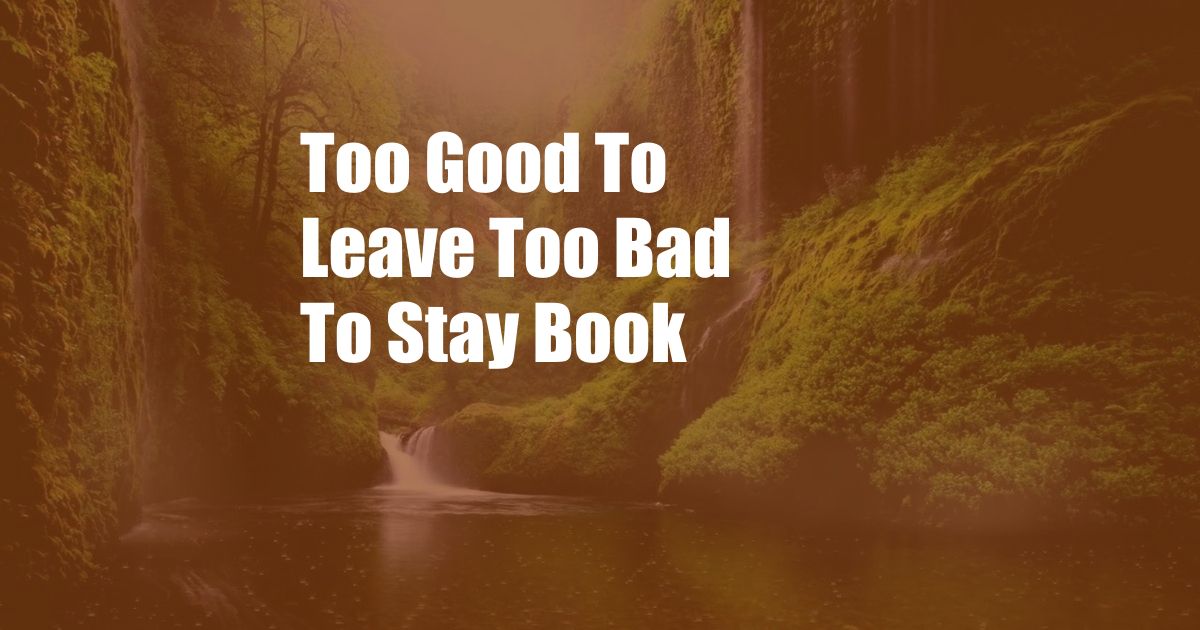
Too Good to Leave, Too Bad to Stay: A Journey of Uncertainty and Growth
In the labyrinthine corridors of life, we often find ourselves at crossroads, torn between staying in familiar surroundings that no longer resonate with our aspirations and venturing into the unknown. This poignant dilemma is eloquently captured in the title of the insightful book, “Too Good to Leave, Too Bad to Stay,” by renowned author and relationship expert Mira Kirshenbaum.
This thought-provoking work delves into the complexities of enduring relationships that have lost their spark, leaving individuals grappling with a profound sense of ambivalence. Kirshenbaum sheds light on the myriad factors that contribute to this emotional impasse, offering a roadmap for navigating the tumultuous terrain of indecision.
A Tapestry of Ambivalence
The decision of whether to stay or leave a long-term relationship is rarely clear-cut. Relationships, like intricate tapestries, are woven with countless threads of shared history, emotional connection, and mutual commitment. Yet, over time, these threads may fray, leaving us questioning the strength of the fabric that once bound us together.
The pain of acknowledging the demise of a relationship can be unbearable, fueling the desire to cling to the familiar, even if it brings little joy. Kirshenbaum emphasizes the importance of acknowledging this ambivalence, recognizing that it is a natural part of the process of re-evaluating our lives and relationships.
Understanding the Cycle of Hope and Despair
Individuals trapped in the “too good to leave, too bad to stay” cycle often find themselves caught in a relentless loop of hope and despair. They may hold on to the faint glimmer of hope that their relationship can be salvaged, only to be met with repeated disappointments. This emotional rollercoaster can take a significant toll on one’s well-being.
Kirshenbaum encourages readers to break free from this cycle by confronting the reality of their situation. She emphasizes the need for self-reflection, honesty, and open communication with one’s partner. By acknowledging the underlying issues that are preventing the relationship from flourishing, individuals can begin to make informed decisions about their future.
Seeking Clarity and Guidance
Navigating the murky waters of ambivalence is no easy feat. Kirshenbaum suggests seeking support from trusted friends, family members, or a therapist who can provide an objective perspective and guidance. External input can help us gain clarity and identify patterns that we may have overlooked.
Self-care is also paramount during this challenging time. Prioritizing our physical and mental health can empower us to approach the decision-making process with greater strength and resilience. Kirshenbaum encourages readers to engage in activities that bring them joy and fulfillment, nurturing their own well-being amidst the uncertainty.
Tips for Making a Difficult Decision
Drawing on her extensive experience as a couples counselor, Kirshenbaum offers valuable tips to help individuals make the difficult decision of whether to stay or leave a relationship.
- Introspection and Self-Reflection: Take time to examine your own needs, values, and goals. Consider whether the relationship is still aligned with your aspirations and whether it brings you more happiness than pain.
- Open and Honest Communication: Communicate your concerns and thoughts openly and honestly with your partner. Be prepared to listen to their perspective and work together to find a mutually acceptable solution.
- Clarity and Boundaries: Establish clear boundaries and expectations for the relationship. If staying together is the preferred option, both partners need to be committed to working on the issues that are affecting the relationship.
- Seek Professional Help: If you are unable to resolve the issues on your own, consider seeking the help of a qualified therapist or couples counselor. An impartial third party can provide support and facilitate productive conversations.
- Trust Your Instincts: Ultimately, the decision of whether to stay or leave is a personal one. Trust your instincts and make the choice that feels right for you.
FAQ on “Too Good to Leave, Too Bad to Stay”
Q: What is the central theme of “Too Good to Leave, Too Bad to Stay”?
A: The book explores the complexities of relationships that have lost their spark, leaving individuals grappling with the difficult decision of whether to stay or leave.
Q: What are some of the factors that contribute to the “too good to leave, too bad to stay” dilemma?
A: Common factors include emotional ambivalence, fear of the unknown, shared history, financial considerations, and societal expectations.
Q: How does the book help readers navigate this difficult decision?
A: Kirshenbaum provides insights into the cycle of hope and despair, encourages self-reflection, and offers practical tips for making informed choices.
Q: What are some key tips for making the decision of whether to stay or leave a relationship?
A: Important considerations include introspection, open communication, establishing clear boundaries, seeking professional help if needed, and trusting one’s instincts.
Q: Is there a right or wrong answer to the question of “stay or leave”?
A: The decision is ultimately a personal one that depends on individual circumstances and values. There is no universally correct answer.
Conclusion
“Too Good to Leave, Too Bad to Stay” is an invaluable resource for anyone navigating the complexities of long-term relationships that have reached a crossroads. Mira Kirshenbaum’s compassionate and insightful writing empowers readers to understand the challenges they face, confront their ambivalence, and make informed decisions about their future.
If you are wrestling with the question of whether to stay or leave a relationship, I highly recommend picking up a copy of this book. It offers a roadmap for finding clarity amidst uncertainty and navigating the path to a fulfilling future.